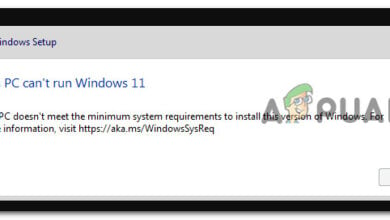Fix: VMware Authorization Service is not Running
Several Windows users are reporting that they encounter the “VMware Authorization service is not running” error when trying to run a virtual machine in VMware Workstation or VMware player. The issue is not exclusive to a certain Windows version since it’s encountered on Windows 7, Windows 8 and Windows 10.

What is causing the “Vmware Authorization service is not running” error?
We investigated this particular issue by looking at various user reports and the repair strategies that are currently being used to fix this particular issue. Based on our investigations, there are several common culprits that are known to trigger this particular error message:
- VMware Authorization service is stopped – As it turns out, this particular issue can occur if the VMware authorization service is stopped. If this scenario is applicable, you can resolve the issue by starting the service from the Services screen or from the System Configuration menu.
- VMware doesn’t have admin rights – The User Account Control (UAC) can be responsible for blocking the application from calling the Authorization Service. In this case, you will be able to resolve the issue by configuring the launcher to launch with admin rights or by lowering down the UAC security settings.
- WMware installation is corrupted – This issue can also occur if the installation folder of VMware contains corrupted or files that are missing. If this scenario is applicable to your situation, you will be able to resolve the issue by using the repair wizard included with VMware.
If you’re currently struggling to resolve this particular error message, this article will provide you with several troubleshooting methods that might just resolve the issue for you. Down below, you’ll find a collection of methods that other affected users have successfully used to resolve the issue permanently.
Since the potential fixes below are ordered by efficiency and severity, we advise you to follow the methods below in the order that they are presented. Eventually, one method should resolve regardless of the culprit that is causing the issue.
Method 1: Starting the VMware Authorization service via Services screen
Most users that we’re encountering the “VMware Authorization service is not running” error have reported that they managed to resolve the issue by accessing the Services screen and starting the service that has been forcibly stopped.
The steps below should be applicable regardless of the Windows version that you’re encountering the issue on.
Here’s a quick guide on starting the VMware Authorization service manually via the Services screen:
- Make sure that VMware Workstation or VMware Player is completely closed (depending on which version you’re using). If you have a virtual machine opened, close it before proceeding to step 2.
- Press Windows key + R to open up a Run dialog box. Then, type “services.msc” and press Enter to open up the Services screen. If prompted by the UAC (User Account Control), click Yes to grant administrative privileges.
- Inside the Services screen, go to the right-hand pane and scroll down through the list of services until you locate the VMware Authorization Service. Once you see it, right-click on it and choose Properties.
- Inside the Properties screen of the VMware Authorization service, go to the General tab, and set the Startup Type to Automatic using the drop-down menu associated with the setting.
- If the Service Status is set to Disabled, click on the Start button directly under the status.
- Click Apply to save the changes, then close the Services screen and restart your computer.
- Once the next startup is complete, open VMware Workstation or VMware Player, launch a virtual machine and see if the issue has been resolved.

If the “VMware Authorization service is not running” error is still occurring, move down to the next method below.
Method 2: Starting the VMware Authorization service via System Configuration
If the first method didn’t resolve the issue or you’re looking for a different approach to do things, you can also start the VMware Authorization service via the System Configuration menu. This is just a different approach to Method 1, but some affected users have reported that for them, this method worked allowed them to start the VMware Authorization service after Method 1 failed.
Here’s a quick guide on starting the VMware Authorization service via System Configuration:
- Press Windows key + R to open up a Run dialog box. Then, type “msconfig” and press Enter to open up a Run dialog box. If prompted by the UAC (User Account Control), click Yes to grant admin access.
- Inside the System Configuration window, go to the Services screen and scroll down through the list of Services until you find VMware Authorization Service.
- Once you manage to locate the service, make sure that the box associated with it is enabled, then click Apply to save the change.
- Restart your computer and see if the issue has been resolved once the next startup is complete now that the service is enabled.

If the same issue is still occurring, move down to the next method below.
Method 3: Running Vmware Workstation / Player with admin privileges
On older Windows versions (particularly on Windows 7), the “VMware Authorization service is not running” error might occur if the application does not have enough privileges to call and open the Authorization services. Several affected users encountering the very same issue have reported that they managed to resolve the issue after they configured the main VMware launcher to launch with admin access at every startup.
Here’s a quick guide on how to do this:
- Right-click on the VMware shortcut or the main executable and choose Properties.
- Inside the Properties screen of VMware, select the Compatibility tab and go down to the Settings screen.
- Once you get there, make sure that the box associated with Run this program as an administrator.
- Click Apply to Save the changes.
- Double-click on the shortcut or executable that you’ve just modified and see if you are able to launch a virtual machine without encountering the “VMware Authorization service is not running” error.

If the same issue is still occurring, move down to the next method below.
Method 4: Preventing the UAC from refusing admin access
As it turns out, this particular issue can also occur in situations where the VMware Authorization services are getting denied when it tries to ask for admin privileges. In most cases, this particular issue is occurring because the User Account Control Settings are too severe and some services needed by VMware Workstation or VMware Player are getting blocked.
Several users encountering the “VMware Authorization service is not running” error have reported that they managed to resolve the issue by loosening the User Account Control Settings. Here’s a quick guide on how to do this:
- Press Windows key + R to open up a Run dialog box. Then, type “useraccountcontrolsettings” and press Enter to open up the User Account Control Settings screen.

Accessing the User Account Control Settings - Once you get inside the User Account Control Settings, adjust the slider to one of the two values at the bottom of the screen. Once you do so, press Ok, then confirm at the UAC (User Account Prompt) prompt.

Adjusting the UAC slider - Once the UAC (User Account Control) settings have been modified, restart your computer.
- When the next startup sequence is complete, open a VMware virtual machine and see if the issue has been resolved.
- If the method wasn’t effective, don’t forget to reverse engineer the steps above and return the UAC to the default values.
If the “VMware Authorization service is not running” error is still occurring, move down to the next method below.
Method 5: Repairing the VMware Workstation / VMware Player installation
As it turns out, the “VMware Authorization service is not running” error can also occur if corruption has made its way into the installation folder of VMware Workstation or VMware Player. Several users that have been encountering this exact issue have reported that they managed to fix it by using the repair wizard of VMware to fix the corrupted files.
The following procedure is confirmed to be effective on both Windows 7 and Windows 10. Here’s a quick guide on repairing Vmware Workstation or VMware Player:
- Press Windows key + R to open up a Run dialog box. Then, type “appwiz.cpl” and press Enter to open up the Programs and Features window. If you’re prompted by the UAC (User Account Control), is important to click Yes to grant admin access)
- Inside the Programs and Features screen, scroll down through the list of applications until you locate VMware Player or VMware workstation – depending on which program you’re using.
- Once you manage to locate the application in question, right-click on it and choose Change.
- Inside the Setup screen, click Yes at the first prompt.
- Then, choose Repair at the next screen to prompt the installer to repair the installation by fixing missing or corrupt files.
- Finally, click Repair and wait for the process to complete.
- Once your VMware product is repaired, restart your machine.
- When the next startup sequence is complete, open Vmware and check if the issue has been resolved.






